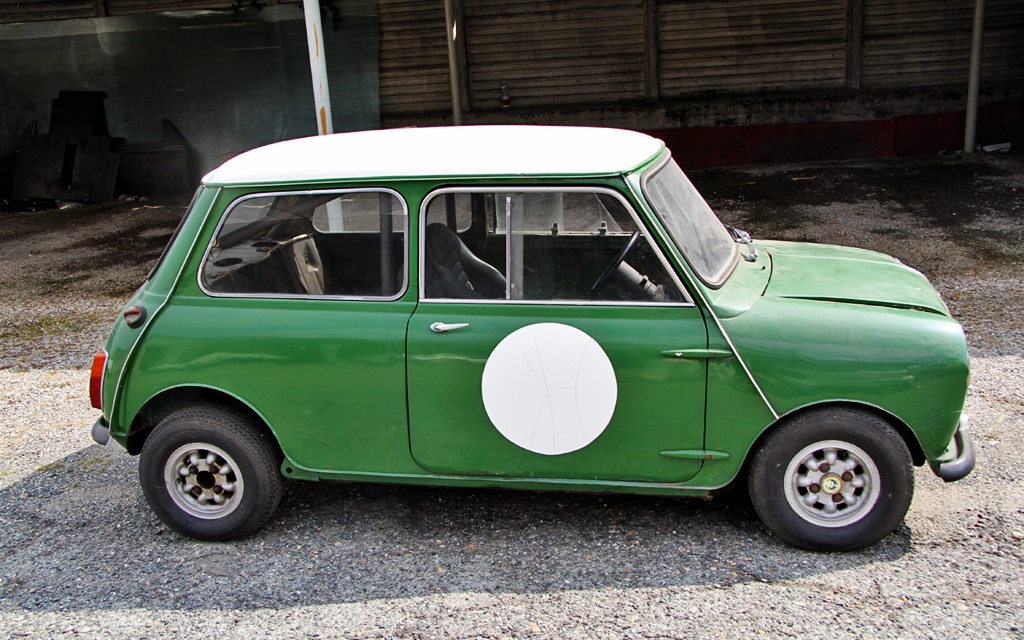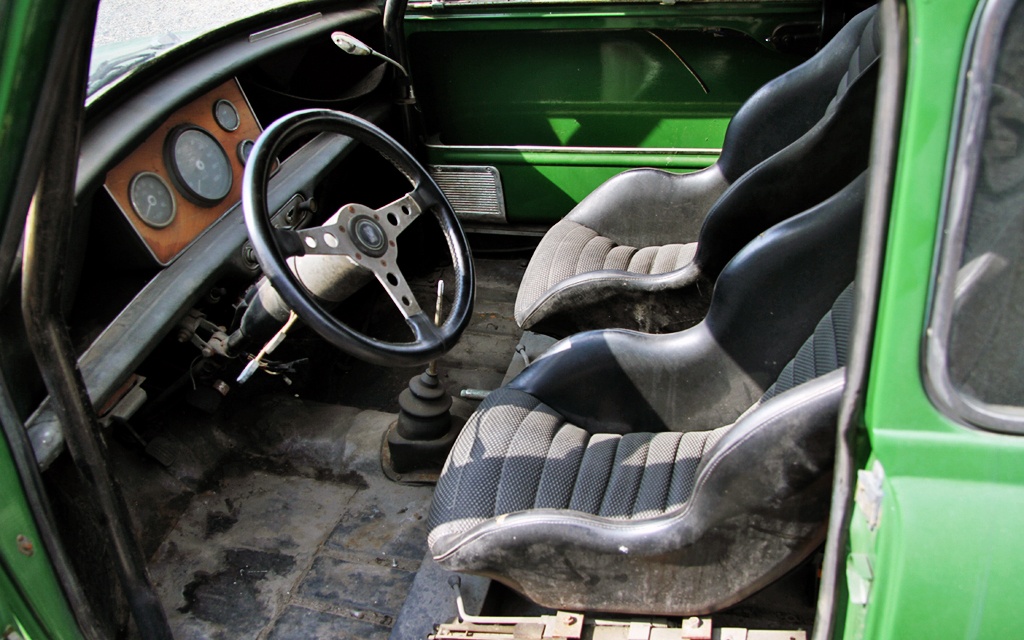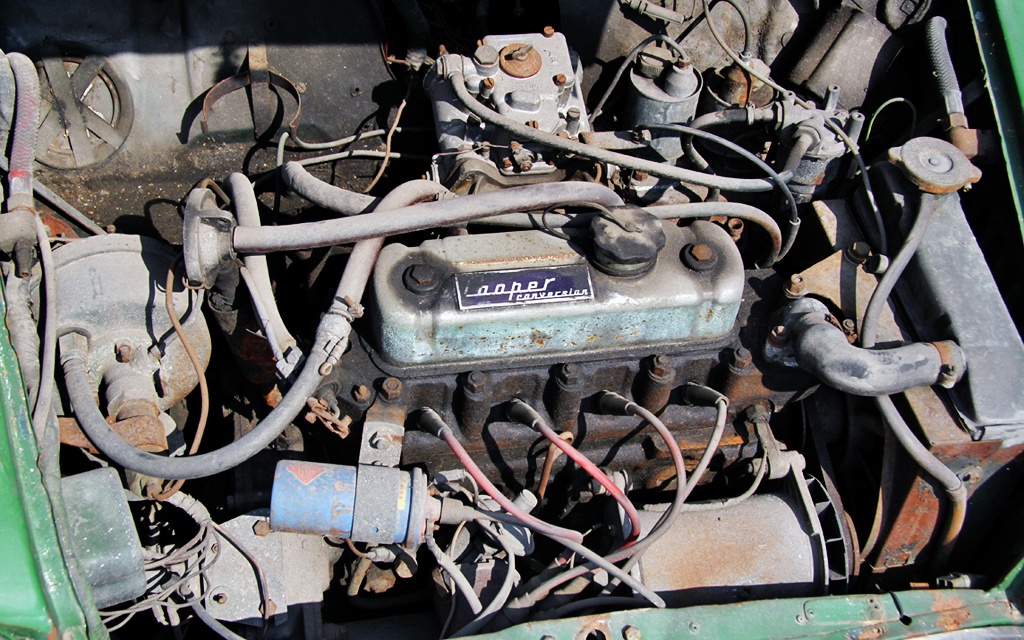Looking at a Morris Mini, it is hard to imagine such a small car flying around Monte Carlo at speed, but after John Cooper was done tuning the Mini it became a force to be reckoned with. The Mini had impressive handling before Cooper got his hands on it, but he gave the Mini the one thing it needed to be competitive, more power. Minis have always been in demand, but the Cooper versions are without a doubt the most desirable of these tiny cars. This 1962 Morris Mini Cooper was discovered in Italy and is in need of a complete restoration. The seller literally provides no information about the car, other than the fact that it needs restored. Thankfully, they offer lots of photos, which can be seen here on AutoClassic.it and if any additional information comes to light, I’ll be sure to add it!
Since the seller didn’t provide much information, I thought this would be a great opportunity to discuss more about the history of the Mini. Most of us know the story about the Mini’s victory at Monte Carlo, but that’s about it. The story behind how these tiny little cars came to be is actually rather fascinating. As with most things, the Mini was born out of necessity. The fuel crisis that followed the Suez Crisis put considerable pressure on British car manufacturers to develop more fuel efficient cars. BMC saw that they were losing considerable market share to German bubble cars, so they commissioned Alec Issigonis to design a new micro car.
BMC gave Issigonis strict guidelines so he had to be rather creative with the design. The number one requirement was that the car be small, but spacious inside. Achieving this took thinking outside the box and had a profound impact on the design. To make things more challenging, BMC also required that the car make use of an existing power plant. Alec saw that the only way he could make a compact car that met the space requirements was to make it front wheel drive. This meant he needed to figure out a way to fit an engine that was designed for rear wheel drive duty into an extremely compact front wheel drive platform. His solution was to mount the motor on top of the transmission in a transverse configuration. This extremely compact configuration proved to be so effective that most of today’s fwd cars use a similar layout.
When Alec first started this project, he wanted to make sure the car offered great handling but was also comfortable to ride in. He initially planned on using a hydrolastic suspension system, but the system wasn’t ready in time, so a different suspension had to be developed rather quickly. The new suspension used rubber cones in the place of springs. While they gave the car a harsh and bumpy ride, it also gave the Mini one of its most enduring traits, go-kart like handling. After a few additional years of development, the car eventually got the hydrolastic system that Alec had wanted.
When the car hit the market, it was a massive success in its home market, but it wasn’t until John Cooper had worked his magic on it that it gained international success. Cooper was a friend of Issigonis and ran a business that built rally and formula one cars. After seeing how agile the Mini was, John approached Alec about developing the car for racing. Alec was against the idea, but after John worked out a deal with BMC, he was forced to collaborate on the project. The first thing that Cooper did to the car was increase power output. The stroke was increased and twin SU carburetors were bolted on, giving the car an additional 20 horsepower. Handling was already impressive, but braking wasn’t up to par, so he installed disc brakes up front. Race cars also tend to destroy transmissions, so a beefier close ratio gearbox was needed.
Cooper’s modifications might sound simple, but rather than make the car an over the top race car they made it an extremely well balanced car that could be consistently and easily driven at its limits. In a time when racing was dominated by V8s, the Mini showed the world that a small car could be fast and fun. This particular Mini could prove to be a blast and I for one wouldn’t mind having it! If it were mine, I would be tempted to leave the exterior as is, get it running great again, and drive it the way Cooper intended! So, anyone here who remembers the day that the Mini beat out the Ford Falcon at Monte Carlo?








Nice website but no information on their cars. If you have to ask then…….
Not a 62
So I contacted the seller and here is the information that he gave me about the car:
The Mini was bought by my father in the eighties, probably as part of a deal, but he doesn’t remember the details. The car was in the same condition then as it is now. My father sold the car to Touring Auto, a big Italian Dealer, at the end of the nineties.
Two year ago we bought back the Mini from Touring Auto and the car still is in the same condition as the eighties! We have never seen a model like this one; possibly a pre series of the Mini Cooper.
As you can see by the papers attached the engine is 848cc and the chassis number is 148597. The head cover has the logo “Cooper Conversion” something similar to the logo “Derivazione Abarth” that we have on some Fiats prepared by Abarth at the period…
The car has two fuel tanks, roll cage and plexi split windows. There are many special features on this Mini. We are thinking of sending this Mini to an auction, but we can also sell privately.
And here is the image of the paperwork that he sent me

Definitely no ’62! The body is a Mk II, so it´s a car from the period between late ’67 and ’69!
If it´s a ’62 in the papers, then it has been reshelled…
Nevertheless, it is a nice car!
The square tail lights weren’t introduced before 1967….
makes a midget/sprite look big. yes i do remember when they won at monte carlo rally and a lot of other events. still not a good idea to put the trans/diff in the oil pan and run very small wheel/tire dia. that result in high output/half shaft speeds when driving at highway speeds. beat the rubber donuts and the rest of the parts to death very fast. very interesting find.
obviously not a 1962,the taillights give that away,I thought mini coopers were Austins??? This ones a MG,sure looks like fun tho
Mini’s were Austins but had other variants as well, this one is probably a 67 because of the square tail lights as mentioned above this was the beginning of the side marker requirement it appeared at the back & by 68 they were added to the front fenders. The rims are a knock off of the famous for the era Minilites rims. I had a Morris Minor same body but had an 850 cc or maybe an 843, can’t remember. They also came with an 1100 cc & the cooper 1275. Cool car looks much lower then stock.
If I remember correctly, the engine choices got bigger with the newer cars, the earliest being 843cc, then bumped up to 1098cc, and finally to 1275 cc in 1967. The A-H Sprite and MG Midget engines followed suit.
My first car was a 1965 Austin Mini Cooper. Bought it from a junk yard for $25.00. It had thrown a rod when the owners were on a honeymoon driving up to Montreal. It was towed to the jink yard and abandoned. I bought it about 3 years after arriving at the junkyard. I was “walking” it home (door open one hand on the steering wheel, the other hand on the roof when I got stopped by a cop. He informed me it was illegal to even walk an unregistered car hom on public roads, so he called a tow truck and my $25 investment quickly became a $50 investment. I was 15 at the time, so this was a big amount of money for me. The car was a left hand drive and just about rust free. But I never did get it running, and 3 years later I traded it for a racing go kart.
If this Mini really does have an 848 cc engine, it’s not a Mini Cooper engine (or block). The first ones had 997 cc, then 998 cc, then over a liter in later years. Also, they had two SU carbs. This has a single two-barrel on a different manifold, although I have seen them modified that way.
In the interior the seats are wrong, and those seat rails are bloody awful. And the instrument binnacle should be oval shape, not square. This one is probably an aftermarket item.
Probably an easy resto of the body before the paint, but the new owner will need to do some parts chasing to get it right, assuming that he wants it that way instead of messed with—-I mean “modified”.
I owned a regular Mini for about 3 days once, then had to sell it. They are just not for me. Maybe part of my problem is that I drove a real Mini Cooper with one of the larger engines and it drove so well and sounded so good that I guess I couldn’t make do with a regular Mini after that. There really is a very big difference.
The car is chassis number M/A2S4SL – 148597
The general format for these early cars is:
A-A2S7L-###A
First position (“A” in the above example):
A = Austin (other than Cooper and S)
C = Austin Cooper or Austin Cooper S
K = Morris Cooper or Cooper S
M =Morris
R = Riley
W = Wolseley
Second position (also “A” in the above example):
= A series engine. Any standard Mini engine for the period:
848cc
970cc Cooper S
997cc Cooper
998cc Cooper and non-Cooper
1071cc Cooper S
1275cc Cooper S
Third position(s) (“2S” in the above example):
= Body type:
2S = 2-door saloon/sedan. Caution: bureaucratic bungles often interpret this as 25 (twenty-five)
B = Moke (“Buckboard”!)
U = Pick-up. Caution: U and V can be mistaken one for the other.
V = Panel van. Caution: U and V can be mistaken one for the other.
W = Estate (with or without wood). Officially, “Dual-purpose”
Fourth position (“7” in the above example):
= Series of Austin, or Morris, etc.:
1 = Mk I Riley Elf, Wolseley Hornet, and Austin/Morris Moke
2 = Mk II Riley Elf or Wolseley Hornet
3 = Mk III Riley Elf or Wolseley Hornet
4 = Mk I Morris
6 = Mk II Morris
7 = Mk I Austin
B = Mk II Austin
Fifth position (“L” in the above example):
D = De-Luxe.
L = Left hand drive. Right hand drive was not designated
S = Super De-Luxe
Number positions (“###” in the above example):
= The sequential build number:
Standing these data the Mini chassis M/A2S4SL – 148597 is:
M: Morris
A: engine 848 (included in the standard Mini engines of the period)
2S: 2 doors saloon/sedan
4: MK I Morris
S: Super De-Luxe
L: Left Hand Drive
148597: 1962 chassis number
There is a register where is stated the first Super De-Luxe chassis was the number 148817, built in 1962.
This car is probably a pre-series of the Super De-Luxe and possibly one of the first prepared by Cooper.
By these proofs there is no doubt the car is a 1962 Mini Morris MK I (as also stated in the Italian papers of the car).
In more than 50 years is quite frequent a car can be updated/modified with features of the newer models.
This is a race car, thats a Weber for a carb, But I still thought a mini cooper was an Austin and they had 1275’s
My friend had one Mini Cooper s and one base Mini, one day we went to the restaurant on our break from work with the Cooper, this little beast was a blast to ride in it, just turning corner with it was hair raising. I kept a good souvenir of the little car.
It’s a Mk II body,they have a larger rear window and the previously noted square post ’67 rear lamps. Not surprised it has been rebodied as rust or crash damaged from being rallied. The clues are there,the roll cage,Weber carb,bucket seats and map light on passenger side hint at that. It is showing signs of a heavyish hit at the front the bonnet is out of line,broken light and front grille area is pushed back. Any potential buyer should check the subframe at the front as it could have been a big impact. Had a Mini Pick Up as my first car,it had a 1075cc engine so was pretty fast as they don’t weigh much! and it was British Racing green too. Great little project for someone they make a cheap fun rally car for historic racing.
Want to see something crazy being done with a vintage Mini? Search for “Project Binky” on YouTube. Some great English humor interspersed with a diary of what appears to be a quality build/conversion to something non-Mini….. That still looks Mini.
What is certain is that the shell is a mark 2 from post 1967.
If the engine is 848cc it never was a cooper.
Generally its a “bitsa” with no collector value.
Austin and Morris badging of the cars was about equal, never an MG.
The first cooper was a long stroke 997cc
Later british leyald produced the 998cc engine which was a shorter stroke with a bigger bore and much more tuneable
The first “S” was a 1071 cc but there was considerable problems with engine crank case breathing and oil getting past the crank oil seal and onto the clutch.
Then came the 971 and 1275 “s” cars with disc front brakes.
You can tell the “s” engines by the two extra cylinder head bolts.
The 971 “S” was a limited production engine for homologation purposes to race in the 1000cc class.
Most popular was the 1275 which had more torque.
Later on Leyland produced a non-S engine which had a cheaper non-nitrided crankshaft and I believe a simpler cylinder head.
However, it looks like a solid shell and you could restore it to resemble any mini through the years.
Refer to Dave Vizard’s book of mini tuning.
I forgot to say that the green colour is the wrong shade!
Why nobody talk about the “Cooper Conversion” emblem on the engine?
Simon, Cooper were not doing conversions on minis in the late 60s.
This car is probably out of the Innocenti factory in Italy which would explain the unusual carburettor , paint colour etc. Leyland sent complete kits of parts to Milan for assembly.
Innocenti also built a really nice hatch back to take the mini parts, and top of the line was called a De Tomaso which had a 1275 clubman engine (cheap version of the S) . The shell was built for either left or right hand drive. Leyland did not import it and those that were privately imported have mostly rotted away.
M/A2S4SL – 148597 please note you are talking about this chassis number…
Simon
Really the “clincher” is visible under the bonnet. Look closely at either side and you can see the hydrolastic top-up valves.
This makes it a post 1964 car.
So the documentation is a fake.
I suggest to the moderator to remove such an heavy comment like the last one made by “Julian”. It may be cause of problems.
Simon
I sincerely apologize if I have upset you or anyone else.
I worked fairly continuously on minis from 1962 until 1968 with Motortune ltd. and other companies. I have owned numerous minis of all varieties including Innocentis and Gts.
Even now there is a modified Mini Mayfair sitting in my drive.
But I’m getting old, memories are fading and who am I to dispute the facts.
The mini, THE definition of Britian and its motorsport at one stage, I however find them a bit small and at 6’4″ tall I find most cars small, I do however love the Minis look so I’m considering getting a 1300
Wooden dashboard, ashtray, blinkers, brake booster, voltage regulator from a Spanish Mk2 Mini – probably a 1275 C so from 1968/9 onwards.
It would be interesting to know the engine number.
Strange but the door handles are definitely not Authi items.
Sorry – 1968 onwards.